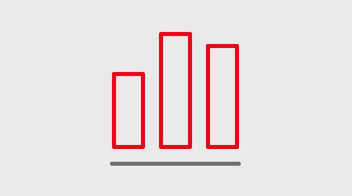Developments in the relevant markets
German passenger transport market
In passenger transport our objective is to maintain our strong market position in the rail and bus transport market in Germany in the long term.
Passenger transport market in Germany / % based on volume sold | Growth rate | Market share | ||
2023 | 2022 | 2023 | 2022 | |
Motorized individual transport | +1.8 | +3.2 | 83.9 | 84.6 |
Rail passenger transport | +7.6 | +65.3 | 9.8 | 9.3 |
DB Group | +8.5 | +65.5 | 7.9 | 7.5 |
Non-Group railways | +4.1 | +64.6 | 1.9 | 1.9 |
Public road passenger transport | +6.4 | +30.2 | 5.9 | 5.7 |
DB Group | +19.1 | +11.9 | 0.6 | 0.5 |
Air transport (domestic) | +21.1 | +93.2 | 0.5 | 0.4 |
Overall market | +2.7 | +8.5 | – | – |
The data for 2022 and 2023 is based on information and estimates available as of February 2024.
In 2023, the volume sold of German passenger transport increased significantly once again, but was still characterized by the changing mobility behavior in the wake of the Covid-19 pandemic. Overall, demand for transport remained below
the pre-Covid-19 level. Transport policy measures such as the Germany-Ticket also boosted passenger transport. Overall, the German passenger transport market recorded growth, although the extent and momentum of development in the individual market segments varied:
- Motorized individual transport continued on the path to recovery in 2023. As in the previous year, volume sold increased slightly in 2023. It benefited from increased demand for mobility compared to previous years, which were more heavily influenced by the impact of the Covid-19 pandemic.
- Domestic air transport also recorded an increase in demand in 2023. The high amount of travel in the summer months in particular led to a significant increase in volume sold. Despite the strong recovery, the market share remains at a very low level.
- Rail passenger transport recorded a further increase in volume sold in 2023.
- From May 2023, regional rail passenger transport in particular benefited from the introduction of the Germany-Ticket.
- Demand for long-distance rail passenger transport was characterized by the return of private and business travelers. Volume sold in the long-distance rail passenger transport market was significantly higher than in the corresponding quarter of the previous year, especially in the first quarter of 2023. In the subsequent quarters, volume sold continued to increase and even exceeded the pre-Covid-19 level for 2023 as a whole. This was due to catch-up effects in the private travel segment and the expansion of services offered by DB Group, FlixTrain and other non-Group railways.
- Public road passenger transport was also up in 2023. The Germany-Ticket led to an increase in volume sold over the course of the year, although public road passenger transport continued to suffer from lower commuting journeys. The increase in the sub-segment of local bus transport significantly exceeded the growth rate of public road passenger transport and was similar for intra- and non-Group providers.
- Long-distance bus transport also increased in terms of volume sold in 2023. This was due to the still very restricted services, particularly at the beginning of 2022 due to the Covid-19 pandemic.
German freight transport market
Freight transport market in Germany / % based on volume sold | Growth rate | Market share | ||
2023 | 2022 | 2023 | 2022 | |
Rail freight transport | –5.9 | +2.8 | 19.1 | 19.2 |
DB Group | –12.2 | –1.1 | 7.3 | 7.9 |
Non-Group railways | –1.5 | +5.8 | 11.7 | 11.3 |
Road freight traffic | –4.5 | –0.5 | 72.2 | 71.9 |
Inland waterways | –7.0 | –8.4 | 6.2 | 6.3 |
Long-distance pipelines | –4.0 | +12.6 | 2.5 | 2.5 |
Overall market | –4.9 | –0.1 | – | – |
Data is based on information and estimates available as of February 2024. Volume sold in rail freight transport according to the Destatis definition of transport services that are primary freight carriers.
German freight transport performance was continuously below the previous year’s level during 2023. The increased factor costs adversely affected transport operators in terms of costs and forced them to make significant price increases. This exposed smaller transport companies in particular to an existential threat. High inflation led to negative consumer sentiment. This was mainly expressed in declining volumes in combined transport. In addition to the high price level, the increase in interest rates led to a slump in demand in the construction industry. Industrial activity was also weak. The chemicals industry reduced production due to sales difficulties, and the decline in steel production, including products along the value-added chain, also led to reduced demand for transport. The supply problems in previous years due to the Covid-19 crisis dissipated to a large extent over the course of the year. Companies are focusing increasingly on supplier diversification in the procurement of raw materials and preliminary products.
In addition to the economic challenges, there was an ongoing acute shortage of personnel in the transport industry. Freight transport volume sold in Germany in 2023 was significantly below that of the previous year.
Rail freight transport
Rail freight transport was also consistently below the previous year’s level during 2023, with the sharpest declines recorded in the third quarter. Heavy losses were incurred in transport for the coal and steel industry, such as ore, coke, crude steel, metal products and scrap. Chemical transport also recorded significant declines due to weak sales, especially for basic chemicals on the global market. Coal transport, which was so strong in previous years, lost out significantly due to changes in the framework conditions for energy supply. The automotive industry recorded a positive trend in transport, which is still in catch-up mode following material bottlenecks in previous years. Mineral oil transport also increased significantly.
The market share of rail freight transport declined slightly. DB Group railways had a below-average performance, while non-Group railways recorded only slight declines.
Road freight traffic
Road freight traffic, like rail, has been below the previous year’s level since the beginning of the year. In addition to the negative trend in the industrial sectors, the low demand for consumer goods as well as the weak construction economy due to high interest rates and the associated low order books in particular led to significant declines. In contrast to rail, the price increases for trucks in 2023 were at a normal level, as the transport companies had already applied significant increases in the previous year. Overall, road freight traffic lost a similar volume to rail in percentage terms. Trucks registered in Germany lost more than trucks registered abroad.
The market share of road freight traffic increased slightly due to even greater losses of other modes of transport.
Inland waterways
After significant declines in performance in the previous year, inland waterway transport in 2023 was unable to benefit from the positive baseline effects of the extreme low water in the previous year and, on the contrary, lost even more quantity. The main drivers of the declines were the loss in volume of coal transport by more than one-third and a decline in grain and steel transport. In contrast to the market situation, construction and consumer goods, stone and earth transport and container transport, which are less relevant for the overall volume of inland waterway transport, improved. Mineral oil transports developed positively in line with the market trend. Due to the lower declines overall in intermodal terms caused by the already very low volume, inland waterway transport recorded slight gains in market share in 2023.
European rail freight transport market
Volume sold in European rail freight transport (EU 27, Switzerland, Norway and the United Kingdom) declined significantly in 2023. The weak economic environment, combined with high inflation and high costs, especially in traction current prices, also had a substantial impact on the European rail freight transport market in 2023. As a result, there was a significant decline in demand for transport, especially in energy-intensive sectors such as chemicals and steel. Weak European foreign trade led to significant declines in container volumes in the North Sea ports of Antwerp, Rotterdam and Hamburg, resulting in a double-digit decline in combined transport. DB Cargo was unable to escape this negative market environment. The volume sold also declined significantly in line with the market trend.
International freight transport and logistics markets / % | Growth rate | |
2023 | 2022 | |
European rail freight transport (based on tkm) | –6.9 | –0.1 |
Figures are based on information and estimates available as of February 2024.


